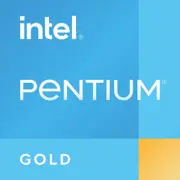Intel Pentium Gold G5400T

Intel Pentium Gold G5400T: Budget Processor for Basic Tasks
April 2025
Key Features: Coffee Lake in a Compact Form Factor
The Intel Pentium Gold G5400T processor, released in 2018, remains relevant for budget builds due to its energy efficiency and support for modern technologies.
Architecture and Manufacturing Process
- Codename: Coffee Lake (14 nm).
- Cores/Threads: 2 cores, 4 threads (Hyper-Threading).
- Cache: 4 MB L3.
- Base Clock: 3.1 GHz (no turbo boost).
- TDP: 35 W.
Performance
- Geekbench 6: 653 (single-core), 1253 (multi-core).
- Integrated Graphics: Intel UHD Graphics 610 (base frequency 350 MHz, max frequency 1050 MHz).
Key Features
- Support for 4K@60 Hz via HDMI 1.4 (HDR limitation).
- Intel Quick Sync Video technology (video encoding acceleration), Virtualization.
Compatible Motherboards: LGA 1151v2 Socket and Chipsets
The processor uses the LGA 1151v2 socket but requires motherboards with 300 series chipsets:
- H310/B360/H370/Z370/Z390.
Selection Recommendations
- For Office PCs: H310 boards (e.g., ASUS Prime H310M-K, ~$60) — minimal ports but stable operation.
- For Multimedia: B360 (MSI B360M PRO-VDH, ~$80) — supports USB 3.1 Gen2 and M.2.
- BIOS Update: Some boards require flashing for compatibility with Coffee Lake.
Practical Example:
A user built a PC with G5400T and ASRock H310CM-HDV but encountered the need to update the BIOS through a service center, as the board was released before the processor.
Supported Memory: DDR4 and Dual-Channel Mode
- Memory Type: DDR4-2400 MHz (officially).
- Maximum Capacity: 64 GB (depends on the motherboard).
Recommendations:
- Use dual-channel mode (2×4 GB or 2×8 GB) to enhance UHD 610 graphics performance.
- Example module: Kingston HyperX Fury 8GB DDR4-2400 (~$25 each).
Important: Frequencies above 2400 MHz are not supported by the processor, even if the board allows for overclocking.
Power Supply: Calculation Based on TDP
With a TDP of 35 W, the processor consumes minimal power, but it's important to consider other components:
- Without a discrete graphics card: A 300 W PSU is sufficient (e.g., EVGA 300W, ~$35).
- With a GTX 1650-level graphics card: A 450 W PSU (Corsair CX450, ~$55).
Sample Build:
- Pentium G5400T + 8 GB DDR4 + 256 GB SSD + 1 TB HDD = 150–180 W under load.
Pros and Cons
Advantages:
- Low power consumption (ideal for HTPCs or mini-PCs).
- Price ~$60 (new, April 2025).
- Support for 4K and hardware video decoding.
Disadvantages:
- Only 2 cores: weak multi-threaded performance.
- UHD Graphics 610 struggles with modern games.
- Memory frequency limitation (2400 MHz).
Use Cases
1. Office Tasks: Document work, browsing, Zoom.
2. Multimedia: 4K video playback, streaming via Plex.
3. Light Gaming: Minecraft, Dota 2, League of Legends (on low settings, 720–1080p).
Real-life Example:
A user built a media center with G5400T to connect to a TV. The system reliably plays 4K HDR through Kodi but stutters when running games in Steam Big Picture mode.
Comparison with Competitors
- AMD Athlon 3000G (2 cores/4 threads, Vega 3):
- Cheaper (~$50), but weaker in single-core tests (Geekbench 6: ~550).
- Ryzen 3 3200G (4 cores/4 threads, Vega 8):
- 30% higher performance in multi-threaded tasks but more expensive (~$80).
Conclusion: The G5400T wins in energy efficiency but loses in multitasking capabilities.
Practical Assembly Tips
1. Motherboard Choice: B360 is the optimal option for balancing price and functionality.
2. Memory: Be sure to use two DDR4-2400 modules.
3. Storage: SSD of 240+ GB (e.g., Kingston A400, ~$30) will speed up OS boot time.
4. Cooling: A standard boxed cooler will be sufficient even under load.
Warning: When upgrading an old PC, check the motherboard’s BIOS for processor support.
Final Conclusion: Who Should Consider the G5400T?
This processor is worth choosing if:
- You need a cheap PC for office work, studying, or internet browsing.
- You require a quiet system with minimal power consumption (e.g., home server).
- The budget is limited, and tasks do not demand multitasking.
Why you shouldn’t choose it:
- If you plan on gaming or video editing, it’s better to add $20–30 and get a Ryzen 3 3200G.
As of April 2025, the G5400T remains a niche solution, but it is still relevant for its intended tasks.
Basic
CPU Specifications
Memory Specifications
GPU Specifications
Miscellaneous
Benchmarks
Compared to Other CPU
Share in social media
Or Link To Us
<a href="https://cputronic.com/cpu/intel-pentium-gold-g5400t" target="_blank">Intel Pentium Gold G5400T</a>